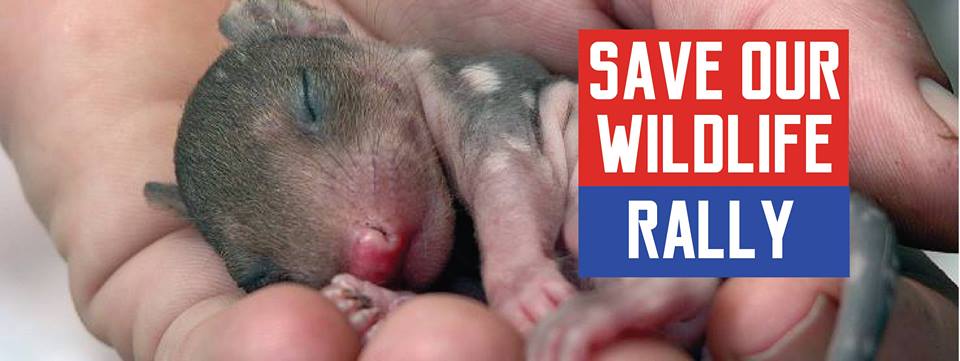Inbox and Environment News: Issue 285
October 16 - 22, 2016: Issue 285
More Than 2.2 Million Hectares Of NSW Koala Habitat Could Be Cleared
14 Oct 2016: WWFWWF-Australia has commissioned a report that finds more than 2.2 million hectares of koala habitat could be cleared under proposed changes to tree clearing controls in NSW.
That represents about 10% of the known or likely koala habitat in NSW.
In total more than 8 million hectares of the state’s trees, forests and woodlands could be bulldozed.
The NSW Government is introducing four new self-assessable codes for land clearing: management, efficiency, equity and farm planning.
Environmental consultancy Eco Logical Australia analysed the potential impacts of just one of those codes - the Equity Code.
WWF-Australia commissioned this report because the NSW Government has failed to provide any estimates of the impact on clearing rates from these proposed changes and all freedom of information requests have been denied.
“Under what’s proposed tree clearing will be out of control,” said Dr Francesca Andreoni, WWF-Australia Forest and Woodland Conservation Policy Manager.
“We can’t allow our last remaining areas of forest and bush to be bulldozed.
“Scientists have warned that the new laws could see a return to broad scale clearing in NSW – this report is further proof that they’re right.
“There are already major concerns about koalas with fears they are rapidly disappearing in New South Wales.
“This amount of clearing would put koalas and many other species of wildlife in the express lane to extinction in NSW,” she said.
About 38% of the trees, forests and woodlands that remain in NSW could be cleared, much of it out west.
In fact in the Western Local Land Services Area, about 84% of the remaining bush could potentially be cleared.
Other parts of the State with large areas that could be cleared under the Equity Code include:- The North West LLS (nearly 800,000 ha making up 45% of total mapped woody vegetation)- Northern Tablelands LLS (over 500,000 ha making up about 29% of total mapped woody vegetation), and- The Central West LLS (nearly 500,000 ha making up 39% of total mapped woody vegetation).
Over 2.2 million hectares of forests identified as either known or likely koala habitat could potentially be cleared under the equity code.
This equates to about 13% of the mapped forests and woodlands across the State.
Local government areas with the greatest potential impact to koala habitat include:- Walgett LGA (183,420 hectares) in the North West- Warrumbungle LGA (164,964 hectares) in the Central West- Inverell LGA (105,917 hectares), in the Northern Tablelands- Tenterfield LGA (164, 035 hectares) in the Northern Tablelands, and- Clarence Valley LGA (150,945 hectares) in the North Coast
Read Eco Logical Australia 2016. Potential Vegetation clearing under Proposed NSW LLS Act Equity Code – Analysis Paper. Prepared for WWF-Australia. HERE
Distribution of lots (properties) which may meet the Equity Code criteria: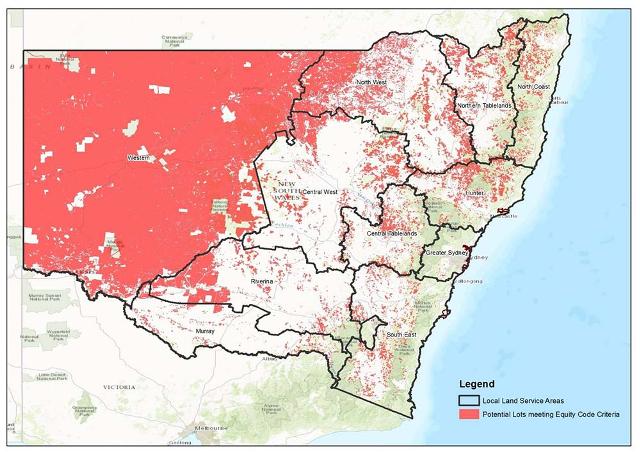

Save Our Wildlife Rally
Wednesday, October 19 at 12:30 PM - 1:30 PMParliament of NSW6 Macquarie Street, Sydney, Australia 2000
The fate of our wildlife rests in your hands. A proposal to weaken land-clearing laws could be voted on in Parliament as early as next week. If it passes, this would be the biggest weakening of our environmental protections in decades.
The changes have been widely criticised by scientists, local government and conservation organisations as they will push our threatened species like the koala, quoll and pygmy possum to extinction. We need to turn out in force to stop these changes!
Join the Save Our Wildlife rally and SHARE with your networks!
Save Our Wildlife Rally
Top 10 Concerns With The Draft Biodiversity Conservation Bill 2016 AndLocal Land Services Amendment Bill
By EDO NSW Policy and Law Reform Director Rachel Walmsley13 May 2016
The NSW Government’s proposed biodiversity legislative and policy package removes many of NSW’s long-held environmental protections, and represents a serious backward step for environmental law and policy in New South Wales. Here are EDO NSW's top 10 concerns with the draft Biodiversity Conservation Bill 2016 and Local Land Services Amendment Bill.
1. Repeal of the Native Vegetation Act and environmental standards that go with itThe Local Land Services Amendment Bill replaces the Native Vegetation Act and its world class Environmental Outcomes Assessment Methodology (EOAM) with self-assessable Codes, exemptions and discretionary clearing. There are no clear environmental baselines, aims or targets. There is no ban on broadscale clearing, no mandatory soil, water and salinity assessment, and no ‘maintain-or-improve’ standard to ensure environmental outcomes – either at the site scale or at the landscape scale. Provisions are less stringent, less evidence-based, less accountable, and are likely to result in significant clearing increases in NSW.
2. Heavy reliance on flexible and indirect biodiversity offsetsThe proposed scheme is heavily reliant on ‘offsetting’ biodiversity impacts (by managing other areas for biodiversity) rather than preventing the impacts, and adopts the standards of the problematic Major Projects Offsets Policy. The Biodiversity Assessment Methodology (BAM) is therefore significantly weakened, for example, direct ‘like-for-like’ offsetting requirements are relaxed and can be circumvented. The option to pay money in lieu of an actual offset will result in net loss of certain threatened species and communities. Offset areas and set asides may be further offset later on rather than actually protected in perpetuity.
3. Conservation gains aren’t guaranteed in law, but dependent on funding decisionsThe proposed regime places almost complete reliance on political, budgetary decisions (which may be short-term) to achieve biodiversity gains, rather than on protections in the Bill to prevent continued biodiversity decline. We strongly support incentives and stewardship payments to rural landholders to conserve and protect environmental values, but funding must be supported by rules and targets that stop valuable biodiversity being cleared in both rural and urban areas.
4. Uncertainty and discretionWhile great reliance is placed on a ‘single scientific method’ to inform land-clearing decisions, there is discretion as to whether a consent authority actually has to apply the results. Offset requirements may be discounted based on other subjective considerations. There is even some discretion around “red lights”, i.e., where clearing and development could cause serious and irreversible biodiversity loss. SEPPs, Regulations and variation certificates provide for unnecessary exemptions from standard pathways. This will create uncertainty and loopholes instead of clarity and consistency.
5. Public participation is not mandatoryDecisions and instruments are not invalid even if consultation processes aren’t followed. Public consultation may be based on summary documents, and issues raised in submission may be ‘summarised’ by proponents instead of directly considered by decision-makers. The proposed public register provisions are far less detailed (for example, in terms of providing information about vegetation clearing and set asides).
6. Administration of a complex regimeThe logic of repealing three and a half Acts to create one coherent Act and scheme is actually resulting in a carving up of responsibilities into the Local Land Services Act, Environmental Planning & Assessment Act, the new Biodiversity Conservation Act – and associated regulations, SEPPs and Codes. The NSW Government is departing from a key recommendation of the Independent Biodiversity legislation Review Panel – i.e., that land clearing involving a change of use should be assessed under planning laws – and is instead, handing the vast majority of clearing approvals to the Local Land Services which currently do not have the resources or expertise to carry out these functions. Furthermore, how the legislation will be applied will depend on future mapping, which is likely to be problematic and highly contested.
7. Contradictory legislationOn one hand, the Biodiversity Conservation Bill carries over provisions of our current threatened species laws (like listing threatened species and ecological communities by a scientific committee), while at the same time the Local Land Services Bill will increase known threats to those species. The Bills fail to tackle the conflict between reducing the impact of listed key threatening processes to biodiversity, and permitting more land clearing via self-assessed Codes and discretionary development applications. For example, the Biodiversity Conservation Bill lists “loss of hollow bearing trees” as a key threatening process, while at the same time, the Local Land Services Bill allows clearing of paddock trees without approval.
8. Lower environmental standards for ‘Biocertification’ at the landscape scaleThe revised Biocertification scheme for large areas of land removes the requirement to ‘maintain or improve environmental outcomes’. Instead, it applies the BAM and imposes a broad discretion to impose conditions. It replaces the current positive test with a negative one - to avoid ‘serious and irreversible’ environmental outcomes as a result of biocertification. Removing the current test contradicts the Bill’s aim to conserve biodiversity and ecological integrity at regional and State scales.
9. Uncertain compliance, enforcement, monitoring and reportingThe NSW Government has been unable to estimate how much landclearing will occur under the new relaxed system – in particular, how much clearing will occur under the new self-assessable codes. The proposed legislation includes updated offences and penalties, but there is no indication who will undertake compliance and enforcement responsibilities. The Biodiversity Conservation Bill’s objects include improving and sharing knowledge (including drawing on local and Aboriginal knowledge) and the Biodiversity Panel’s report hinged on high-quality environmental data, monitoring and reporting. However, the legislation does not set clear requirements for these essential elements so it will be difficult to determine how much biodiversity is being lost under the relaxed rules.
10. Missed opportunities for key reformsRewriting our biodiversity laws is a once in a generation opportunity to put in place laws that will actually address the most significant threats to biodiversity. Unfortunately, the proposed legislation does not address necessary and important reforms, for example to address cumulative impacts and climate change impacts of clearing (and potential carbon gain). Instead, the Bill carries over deficiencies of current system for example: exemptions and wide discretion for projects with the biggest impacts (State Significant Development), vulnerable ecological communities are excluded from the definition of threatened species, and mining is still permitted in areas that supposedly offset previous losses and areas of outstanding biodiversity value.____________________________
SeeBiodiversity Conservation Bill 2016 - public consultation draft, NEW SOUTH WALES DRAFT GOVERNMENT BILLLocal Land Services Amendment Bill 2016 - public consultation draft NEW SOUTH WALES DRAFT GOVERNMENT BILL
Community Values At Odds With Crown Lands Sell-Off Plans
13 October, 2016: Nature Conservation Council NSWA report released today by a NSW upper house parliamentary committee found the community opposes government plans to sell off Crown lands, which people cherish for their environmental, social and cultural values. [1]
Off the back of today’s report, the NSW Nature Conservation Council and the NSW National Parks Association are is calling for a full audit of Crown lands to ensure threatened species habitat is adequately protected and never sold.
“Premier Baird is poised to introduce significant changes in Crown lands management without coming clean with the people about what’s really at stake,” Nature Conservation Council CEO Kate Smolski said.
“We have not seen his draft legislation and the government can’t tell us what environmental values are at risk from these proposals.
“The parliamentary report shows that when the government looks at Crown lands, it sees dollar signs, and when the people look at Crown land, they see a rich environmental and cultural legacy that they want protected for future generations.
“Citizens have a right to know what treasures these lands contain before Mr Baird flogs them off or transfers them to local councils.
“Crown lands are often the last remnants of critical threatened species habitat, especially in the heavily cleared inland districts of the state, so the government has a duty to retain and protect them.”
NSW National Parks Association CEO Kevin Evans said: “This report sends a strong signal to the government that its focus on the economic benefits of Crown lands is misplaced and that it should move away from its proposed business-style approach.
“The community has made its views on Crown lands clear. People want them managed for their environmental and cultural values, not as just another resource to be exploited.
“The inquiry recommended the government consider an audit of the ecological values of Crown lands, including its local, regional and state environmental significance.
“We strongly support this recommendation and want to see ongoing protection of areas of high ecological value.”
Both organisations are calling on the government to release a draft exposure bill for community consultation, rather than introduce the bill into parliament without giving the community a changes to see what it contains, as is currently the plan.
TIMELINE2012Government announced comprehensive review of the NSW Crown land estate.
2013Crown Lands Management Review (Carapiet Review) and Government Response
2014White Paper consultation
2015Local Council Pilot Study (confidential)Government released response to White Paper submissions
Early 2016Targeted stakeholder consultation
Late 2016New Bill introduced into NSW Parliament
REFERENCES: [1] Inquiry into Crown land- Report October 13, 2016
BP Announcement On Plans For The Great Australian Bight
NOPSEMA is aware of the announcement by BP Developments Australia (BP) on 11 October that it will not be progressing its exploration drilling programme in the Great Australian Bight. This decision by BP not to proceed with plans to drill exploration wells is a commercial decision for the company, and questions regarding the decision should be addressed to BP.
NOPSEMA has made no further notification to BP following a request for information issued on 28 September, in relation to their environment plan for the drilling of the Whinham-1 and Stromlo-1 wells. The environment plans submitted by BP for drilling in the Great Australian Bight remain under assessment by NOPSEMA. This assessment process will proceed until the environment plans are withdrawn by BP. NOPSEMA has not received a withdrawal request.
To date NOPSEMA has had productive dialogue with BP and other stakeholders, including community interests such as fisheries and environmental groups. NOPSEMA will continue to engage with industry, other interested stakeholders, and the wider community.Questions regarding the plans of other companies holding titles in the Great Australian Bight should be directed to the specific companies.
National Offshore Petroleum Safety and Environmental Management Authority: https://www.nopsema.gov.au/news-and-media/
Independent PAC To Make Final Decision On The Mount Owen Continued Operations Project
12.10.2016: Departmental Media Release - Department of Planning and EnvironmentThe independent Planning Assessment Commission will now make the final decision on the Mount Owen Continued Operations Project near Muswellbrook as the Department of Planning and Environment submits its final assessment report, with recommended strict conditions responding to issues raised by the community.
In its assessment, the Department has carefully considered all recommendations made by the Commission in its February 2016 review, issues raised in public submissions, advice from Government agencies and the findings of independent air quality and economics reviews.
Glencore’s response to the Commission’s review made several changes to the project and these have also been addressed by the Department.
Changes include a revised mine plan which no longer proposes mining from the RERR pit, reducing total proposed coal extraction by six million tonnes and resulting in no additional final voids, beyond those approved for the current mining operations. Glencore also provided updated rehabilitation plans.
Based on its extensive assessment, the Department has recommended approval of the modified proposal and concluded that recommended, stringent conditions would appropriately address all issues raised and effectively minimise the project’s potential impacts.
A spokesperson from the Department said 45 environmental performance conditions have been recommended. A significant number of conditions focus on key issues raised by the community and the Commission such as biodiversity, air quality and mine rehabilitation.
Key updates to the conditions recommended by the Department include:- a stronger air quality management plan requiring the construction of a weather station near the closest affected residences and a proactive dust management plan to better manage dust generating activities at the mine
- strengthened requirements to monitor the mine’s compliance with air quality and noise limits
- strengthened requirements for seasonal flora and fauna monitoring
- strengthened requirements for reporting of biodiversity management, rehabilitation and regeneration measures, including independent audits of the mine’s performance on these measures every three years
- targeted conditions relating to biodiversity offset and rehabilitation outcomes, including a focus on the regeneration of threatened animal and plant species and rehabilitation of their habitats
- voluntary acquisition rights for a total of eight private properties.
“The Department has closely considered the new mine plan and the company’s efforts to address the Commission’s recommendations on the mine’s final landform and rehabilitation. The Department has found the project now meets contemporary standards for final landform design and has recommended seven strict conditions to ensure that rehabilitation meets appropriate standards,” a spokesperson said.
“Glencore’s updated rehabilitation plans propose a new 144 hectare biodiversity offset known as the Mitchell Hills Offset Area, and additional rehabilitated woodland corridors. This brings the total proposed biodiversity offsets to 1,430 hectares, including 518 hectares of rehabilitated woodland vegetation.
“The Commission is an important part of the NSW planning system ensuring major developments are subject to expert, independent review and assessment.
“The Commission will now consider the Department’s report and recommended conditions as well as community submissions to make a final decision.”
For more information visit the Department’s websitehttp://majorprojects.planning.nsw.gov.au/index.pl?action=view_job&job_id=5850
- a stronger air quality management plan requiring the construction of a weather station near the closest affected residences and a proactive dust management plan to better manage dust generating activities at the mine
- strengthened requirements to monitor the mine’s compliance with air quality and noise limits
- strengthened requirements for seasonal flora and fauna monitoring
- strengthened requirements for reporting of biodiversity management, rehabilitation and regeneration measures, including independent audits of the mine’s performance on these measures every three years
- targeted conditions relating to biodiversity offset and rehabilitation outcomes, including a focus on the regeneration of threatened animal and plant species and rehabilitation of their habitats
- voluntary acquisition rights for a total of eight private properties.
National Heritage Listing For Snowy Mountain Scheme
14 October 2016: Media release - The Hon. Josh Frydenberg MP, Minister for the Environment and EnergyThe biggest industrial development Australia has ever attempted, the Snowy Mountains Scheme, today become the 107th place to be added to the National Heritage List.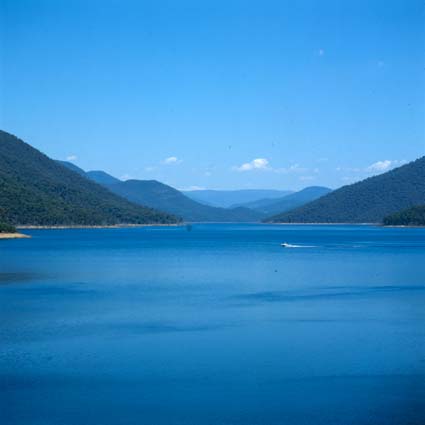
Constructed between 1949 and 1974, the scheme is made up of 225 kilometres of tunnels, pipelines and aqueducts, with only two per cent of the entire construction visible above the ground.
The National Heritage Listed area includes 15 major dams, nine power stations and a pumping station, covering a mountainous area of 4,600 square kilometres in southern New South Wales.
The scheme’s dams, tunnels, aqueducts and power stations are some of the most complex and technical engineering and construction feats in the country and the world. Significant engineering advancements were achieved during the construction of the scheme, including rockbolting and the use of 330 kV transmission lines. Importantly, the scheme was completed on time and on budget.
More than 100,000 people from around 30 countries worked on the Snowy Mountains Scheme.
Seventy per cent of these were migrants displaced from their homes in Europe during the Second World War. These workers and their children lived in towns and camps across the Snowy Mountains during construction and still holds a special significance for workers, their descendants and the wider community as a symbol of multicultural Australia.
The Snowy Mountains Scheme is an audacious and brilliant example of modern Australia—a bold idea brought to life by the hard-work of thousands of people coming to Australia from all over the world.
The Snowy Mountains Scheme remains one of Australia’s largest producers of renewable energy, including nearly a third of renewable energy fed into the eastern mainland grid, and water flowing from the scheme supports over $3 billion in agricultural production.
The scheme’s inclusion in the National Heritage List formalises the important chapter the Snowy Scheme has in the Australian story and cements its place in the nation’s history.
For more details seewww.environment.gov.au/heritage/places/national/snowy-mountains-scheme
Top: Snowy mountains scheme - Talbingo Dam, 1981courtesy National Archives of Australia. Image No.: A6135, K12/1/81/183

Nature In Cities: Can Urban Planners Enhance Human Well-Being Using Biodiversity?
The University of Sydney is conducting a survey on how diverse communities interact with components of nature and biodiversity in cities, and how this affects their well-being.
The results will help urban planners to prioritise specific elements of greenspace in order to maximise the community’s benefit.
Please take a short survey to help with this research.Survey at: https://www.surveymonkey.com/r/CFT77F5
Floating Landcare In The Pittwater/Hawkesbury Area
Volunteers needed:Where: Portugese Beach, Ku-ring-gai Chase National ParkWhen: Tuesday 8th November 2016Time: 8:15am start and return 2:00pmMeet at: Taylors Point Wharf, ClarevilleCost: FREE
RSVP: Essential by Friday 28th October! Please email your name and phone number to floatinglandcare@gmail.com or call Rebecca Mooy at Greater Sydney Local Land Services on 02 4724 2120. Confirmation details will be sent to all volunteers via email on 1.11.20168 volunteers so far, can take another 12.
Amazing progress on the Lantana on the steeper slopes at the southern end of the beach and a sweep through the dune for Aspargus Fern, Cotton Bush and litter. Looking for a few more volunteers to enjoy this trip and help with some follow up. This Beach could also be ideal for a swim in November.
Return transport on an oyster barge will be included as will morning tea, lunch, tools, gloves and bush regen knowledge from Judy Morris and Natasha Funke from NPWS.
To find out more about Floating Landcare:
Northern Gates To Open In Kosciuszko National Park
Media release: 11 October 2016 - Office of Environment & Heritage, NSW GovernmentNational Parks and Wildlife Service (NPWS) plan to open gates to the seasonally closed northern section of Kosciusko National Park this weekend, from Friday 14th October, following an extended closure due to bad weather.
NPWS Regional Manager, Mick Pettitt said visitors can now safely access Long Plain, Currango Homestead, Blue Waterholes and other popular sites across the northern section of the Park.
“Unseasonal late snowfalls and wet weather forced us to delay opening these gates earlier this month to ensure visitor safety,” Mr Pettitt said.
“Inclement weather created hazardous road and driving conditions and we had incidents of trees falling across trails.
“Late snowfall also meant some sites were not suitable for vehicle access.
“The extended closure also prevented serious damage being caused to our trail network and campgrounds.
“Delaying access now means that these trails are in reasonably good condition and can be accessed and enjoyed by visitors.
“Most gates, trails and campgrounds in the northern section will be open from Friday 14th October,” Mr Pettitt said.
Unfortunately Broken Cart Trail remains closed due to very wet conditions and treefalls across the trail.
NPWS reminds visitors to check NPWS Alerts before coming to the park to get up to date information on closures still in place and check local conditions.
For more information on Kosciuszko National Park, go to the NPWS Website or call the NPWS Tumut Visitor Centre on 6947 7025 or NPWS Jindabyne Visitor Centre on 6450 5600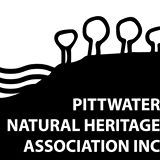
SUNDAY MORNING BIRDWATCHING with PNHA
Would you like to know more about our local birds and explore our bushland reserves? Then join us on one of our bird walks:
Our last walk of the year is at 7.30am on Sunday 27 November at Warriewood Wetlands. The summer migratory species will have arrived and the Wetlands will be home to nesting birds and birds with young. there should be plenty to see.Meet at Katoa Close, North Narrabeen.
Most walks last a couple of hours. Bring binoculars and morning tea for afterwards if you like. Contact pnhabirdwatching@gmail.com for details of each walk.

SUNDAY MORNING BIRDWATCHING with PNHA
Would you like to know more about our local birds and explore our bushland reserves? Then join us on one of our bird walks:
Our last walk of the year is at 7.30am on Sunday 27 November at Warriewood Wetlands. The summer migratory species will have arrived and the Wetlands will be home to nesting birds and birds with young. there should be plenty to see.Meet at Katoa Close, North Narrabeen.
Most walks last a couple of hours. Bring binoculars and morning tea for afterwards if you like. Contact pnhabirdwatching@gmail.com for details of each walk.
Have Your Say On The Extension Of Martins Creek Quarry
13.10.2016: Departmental Media Release-Department of Planning and EnvironmentA proposal by Buttai Gravel Pty Ltd to extend the Martins Creek Quarry near Maitland will be on exhibition from today for community consultation.
The Department of Planning and Environment is keen to hear the community’s views on the proposal, which seeks to:- clear 37.8 hectares of vegetation to expand the existing extraction area
- rehabilitate the quarry site progressively, and after extraction is completed
- extract up to 1.5 million tonnes of hard rock material per year
- increase the hours of operation
- transport processed material to market by road trucks and trains
- construct a new access driveway and bridge.
The project at Station Street in Martins Creek would create approximately 36 jobs when the quarry is fully operational (an increase from the current 24) and provide a substantial number of additional short-term construction jobs.
A spokesperson for the Department of Planning and Environment said the local community always has an opportunity to share their views.
“Community consultation is an integral part of the planning process and the applicant will have to respond to the feedback we receive,” the spokesperson said.
“This feedback is taken into consideration as part of the assessment.
“It’s easy to participate by going online and we encourage everyone to take a look and have their say.”
To make a submission or view the Environmental Impact Statement (EIS), visit www.majorprojects.planning.nsw.gov.au.
Submissions can be made from Thursday 13 October until Thursday 24 November 2016.
Written submissions can also be made to:Department of Planning and EnvironmentAttn: Director – Resource AssessmentsGPO Box 39Sydney NSW 2001
The application and EIS are also available to view in person at:- Department of Planning and Environment: Information Centre, Level 22, 320 Pitt Street, Sydney
- Dungog Shire Council: Council Administration Office,198 Dowling St, Dungog
- Maitland City Council: 285-287 High Street, Maitland
- Nature Conservation Council: 14/338 Pitt Street, Sydney.
- clear 37.8 hectares of vegetation to expand the existing extraction area
- rehabilitate the quarry site progressively, and after extraction is completed
- extract up to 1.5 million tonnes of hard rock material per year
- increase the hours of operation
- transport processed material to market by road trucks and trains
- construct a new access driveway and bridge.
- Department of Planning and Environment: Information Centre, Level 22, 320 Pitt Street, Sydney
- Dungog Shire Council: Council Administration Office,198 Dowling St, Dungog
- Maitland City Council: 285-287 High Street, Maitland
- Nature Conservation Council: 14/338 Pitt Street, Sydney.
Have Your Say On Modifications To A Sand Quarry In The Hills
11.10.2016: Departmental Media Release -Department of Planning and EnvironmentA proposal by Dixon Sand Pty Ltd for modifications to its Haerses Road Sand Quarry in Maroota will be on exhibition from today for community consultation.
The Department of Planning and Environment is keen to hear the community’s views on the proposed modification, which seeks to:- expand the approved extraction area by approximately 19 hectares
- extend the life of the quarry by 15 years until 2046
- use mobile crushers and mobile watering equipment
- import up to 100,000 tonnes per annum of clean recycled natural materials, such as soil and gravel, to be blended with the extracted sand.
A spokesperson for the Department of Planning and Environment said the local community always has an opportunity to share their views.
“Community consultation is an integral part of the planning process and the applicant will have to respond to the feedback we receive,” the spokesperson said.
“This feedback is taken into consideration as part of the assessment.
“It’s easy to participate by going online and we encourage everyone to take a look and have their say.”
To make a submission or view the Modification Application and accompanying documents, visit www.majorprojects.planning.nsw.gov.au.
Submissions can be made from Wednesday 12 October until Thursday 10 November 2016.
Written submissions can also be made to:
Department of Planning and EnvironmentAttn: Director – Resource AssessmentsGPO Box 39Sydney NSW 2001
The Modification Application and accompanying documents are also available to view in person at:Department of Planning & Environment: Information Centre, Level 22, 320 Pitt Street, SydneyThe Hills Shire Council: Customer Service Centre, 3 Columbia Court, Baulkham HillsNature Conservation Council: 14/338 Pitt Street, Sydney.
- expand the approved extraction area by approximately 19 hectares
- extend the life of the quarry by 15 years until 2046
- use mobile crushers and mobile watering equipment
- import up to 100,000 tonnes per annum of clean recycled natural materials, such as soil and gravel, to be blended with the extracted sand.
Nature Conservancy Writing Prize 2017
Enter The Nature Conservancy Australia Nature Writing Prize today!Calling all writers! The Nature Conservancy Australia is delighted to open the fourth biennial Nature Writing Prize.
$5,000 will be awarded to an essay of between 3,000 and 5,000 words in the genre of ‘Writing of Place’. The prize will go to an Australian writer whose entry is judged to be of the highest literary merit and which best explores his or her relationship and interaction with some aspect of the Australian landscape. The competition’s judges are award-winning journalist, author and editor Jo Chandler and novelist and critic James Bradley. The winning entry will be published in Griffith Review online as a multimedia essay.
The prize has been made possible thanks to a generous donation from the McLean Foundation, which promotes and celebrates the art of nature writing in Australia.
The deadline for submissions is January 27, 2017. Click here to learn more about the prize and review the terms and conditions of entry.
$50 Million For New Macquarie Island Research Station
14 October 2016: Media release - The Hon. Josh Frydenberg MP, Minister for the Environment and EnergyAustralia’s science and research capacity will be boosted with the Turnbull Coalition Government set to spend up to $50 million to build a new state of the art research station on Macquarie Island.
This significant investment is in addition to the $2.2 billion the Coalition Government is already investing to support its landmark Australian Antarctic Strategy and 20 Year Action Plan.
The new station will be the most advanced of its type in the Southern Ocean, capable of supporting the full range of priority activities we have conducted in the past and to ensure a permanent and recurring year round presence.
Due to its position as the only base between Australia and Antarctica, Macquarie Island is an important global monitoring location for scientific research, including monitoring southern hemisphere weather and climatic data.
The new station guarantees continued support for high priority science and long-term monitoring by the science community, including the work of the Bureau of Meteorology, Geoscience Australia and the Australian Radiation Protection and Nuclear Safety Agency.
The continued year-round presence on Macquarie Island means integral international weather data will be maintained and that our ongoing global contribution to monitoring radioactive and nuclear activity will continue.
The new modern station will be significantly more efficient than the existing station and be designed to have minimal environmental impact, lower operating and maintenance costs.
The existing station, which is reaching the end of its life, will be decommissioned and the old buildings removed over the next decade. Permanent operations will be maintained in the lead up to the new station being fully operational by 2021-22.
The Federal and Tasmanian governments have a long and proud historical association with Macquarie Island and preserving this heritage will also be a priority. This is a sensible and modern approach to our future research effort in the region while also ensuring we protect what is a precious environmental asset.
Wilderness Horse Riding
Draft amendments to plans of managementDraft amendments to the plans of management for Far South Coast Escarpment Parks, Kosciuszko National Park and Mummel Gulf National Park and State Conservation Area are on public exhibition until 31 October 2016.
The plans of management for the above parks were amended in 2014 to enable a pilot program to trial horse riding in wilderness areas. The trial concluded in April 2016 and is currently being evaluated. The draft amendments propose to allow horse riding to continue in the same locations until 31 December 2017 while the evaluation is undertaken.
Have your sayTo view the draft amendments, visit the Environment NSW website.
Online ConsultationDate: Sep. 16 - Oct. 31, 2016Time: 9:00am — 5:00pm
More Information
Counting On Birdwatchers For Nation-Wide Big White Bird Count
Media release: 10 October 2016 - Office of Environment & Heritage, NSW Government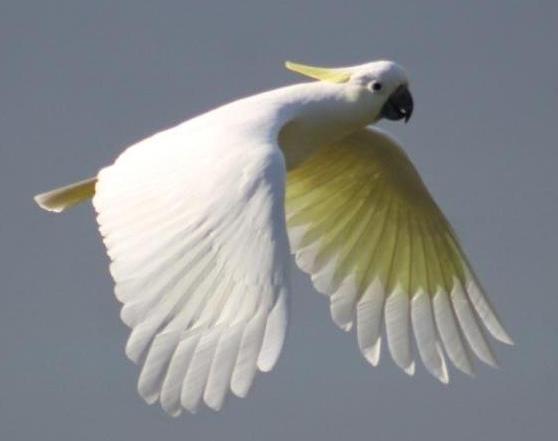
People all over Australia are being asked to help count some of our most loved and misunderstood big white birds in partnership with the Aussie Backyard Bird Count during National Bird Week.
From October 17-23 citizen scientists are invited to participate in the annual Australian white ibis and sulphur-crested cockatoo census coordinated by the National Parks and Wildlife Service (NPWS).
Dr John Martin, Wildlife Ecologist for the Royal Botanic Gardens in Sydney, said the survey aims to better understand the numbers of these native birds, where they breed and the habitats they use across Australia.
“People normally have a good knowledge of their local areas so they can help us by reporting the number of ibis and cockies they observe in their favourite outdoor space,” Dr Martin said.
“Reporting your sightings through the Aussie Backyard Bird Count app is an easy way you can help us determine if current management practices are working.
“Although we are specifically interested to get a more accurate assessment of the ibis and cockatoo populations, the survey asks participants to report all of the species they encounter and the app can assist with bird ID,” Dr Martin said.
Cockatoos and ibis are native to Australia and have both increased in numbers along the coast over the last 40 years in response to drought and changes to the inland woodlands and wetlands.
“Both species have made an incredible adaptation to living within close proximity to humans and have even altered their diet to include hand-outs such as bread,” Dr Martin said.
“The ibis survey began in 2003, since that time more than 2000 ibis have been colour-banded and wing-tagged to enable us to learn more about their movement behaviour.
“They have been recorded moving 30 kilometres between daily foraging sites, with fledglings found to move from Sydney to as far away as Townsville, 2500 kilometres north.
“Since 2011, a similar study has wing-tagged cockatoos at the Royal Botanic Garden in Sydney and from this it appears that the cockies have only moved within 30 kilometres,” Dr Martin said.
In previous years volunteers have counted birds in wetlands and parks from Tweed to Dubbo to Albury and it is hoped the coverage will increase this year.
Participants can submit their data to aussiebirdcount.org.au, the Aussie Bird Count app or through the white ibis survey and cockatoo survey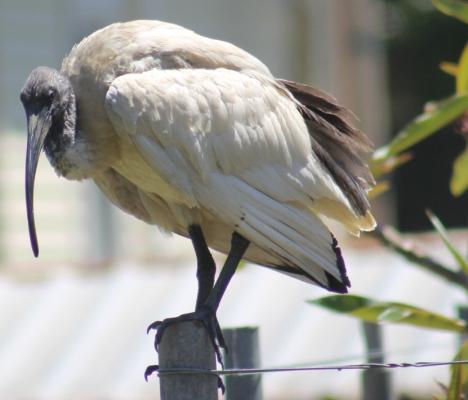

Aussie Backyard Bird Count 2016
This year, the Aussie Backyard Bird Count will be back, bigger and better than ever. With more than a million birds counted last year, how many will we see in 2016? It’s all happening during Bird Week, 17–23 October.Let’s make every bird count!
Discover the Aussie Backyard Bird Count app!A 'how to' guide for using the Aussie Backyard Bird Count app.The app is currently available on:
NSW Coastal Council
October 13, 2016: Office of Environment & Heritage, NSW GovernmentDo you have the expertise to contribute to improved management of the NSW coastline?
The NSW Government is inviting applications for membership on the NSW Coastal Council from those with the relevant technical knowledge and expertise in:- coastal physical sciences, including geomorphology
- coastal engineering
- coastal land use planning
- coastal ecology
- social science
- economics
- local government management
- property law
- dispute resolution
- traditional and contemporary Aboriginal use and management of the coastal zone.
The Coastal Council will provide independent advice to the Minister administering the Coastal Management Act 2016 on coastal planning and management issues.
The Coastal Council will meet in Sydney as required, expected to be 6-8 times in the first year. Appointments to the Coastal Council are paid positions for an initial 18 month to 3 year term.
Members of the Coastal Council will be remunerated at $30,000 per annum. The Chairperson will receive $55,000 per annum. Annual fees will be paid on a pro-rata basis.
Members will be able to demonstrate capabilities to perform the following functions:- provide strategic advice to the Minister, including in relation to the Minister's functions under the Coastal Management Act 2016
- assess compliance by local councils with management objectives and the coastal management manual in preparing and reviewing coastal management programs
- conduct a performance audit of the implementation of a coastal management program of a local council
- provide advice to a public authority on coastal management issues.
To submit an expression of interest please send a cover letter and resume to: coastal.reforms@environment.nsw.gov.auApplications close 31 October 2016.For more information, email
- coastal physical sciences, including geomorphology
- coastal engineering
- coastal land use planning
- coastal ecology
- social science
- economics
- local government management
- property law
- dispute resolution
- traditional and contemporary Aboriginal use and management of the coastal zone.
- provide strategic advice to the Minister, including in relation to the Minister's functions under the Coastal Management Act 2016
- assess compliance by local councils with management objectives and the coastal management manual in preparing and reviewing coastal management programs
- conduct a performance audit of the implementation of a coastal management program of a local council
- provide advice to a public authority on coastal management issues.
NSW Litter Volume Drops
October 12, 2016: NSW GovernmentNSW is almost halfway to meeting the Premier's Priority target to reduce litter volume by 40 per cent by 2020.There has been a 19 per cent reduction in the state's litter volume from 2013-14 to 2015-16, this year's Keep Australia Beautiful National Litter Index results has found.
Environment Minister Mark Speakman said the results showed campaigns, litter reduction programs and public education initiatives were helping to keep our environment clean.
“The message is getting through that we need to prevent litter from ending up in our waterways, beaches and communities, but there is still more to do,” Mr Speakman said.
The latest survey found drink containers made up 49 per cent of total litter volume. The NSW container deposit scheme starting in July 2017 is expected to further reduce this type of litter.
Read the Environment Protection Authority’s 2015-16 National Litter Index Results for NSW (PDF, 824kb)
Gloucester Community Vows To Fight Rocky Hill Coal Mine And Its Impacts On Local Land And Water
October 14, 2016: Lock the Gate AllianceAfter fighting off the AGL CSG project near Gloucester, community group Groundswell Gloucester today reaffirmed its opposition to the proposed Rocky Hill coal mine, as public submissions on the project closed.
Groundswell Gloucester will today hand more than 1,000 community submissions against the project to the Department of Environment and Planning.
Groundswell Gloucester Chair Julie Lyford said, "We’ve shown our strength as a community in standing up for our land and water against coal seam gas and I’m confident we’ll be able to work together to protect our community’s health and tourism industry from this damaging coal mine.
"Community submissions on the Rocky Hill project point out that the proposed mine is less than one kilometre form the Forbesdale residential estate and within five kilometres of Gloucester’s schools, hospital and most of its residents’ homes.
"This is no place for a coal mine. It’s unacceptable for our community to be put at risk of particulate pollution from open-cut mining, which is known to lead to reduced respiratory health and increased death rates in surrounding communities.
"Gloucester is home to a thriving $50 million tourism industry and protecting its sustainability along with the health of our community, is worth far more than the dubious economic claims being made by the mine’s proponents.
"Simply putting conditions on the mine will not be enough to protect our community, which has no reason to trust conditions will be complied with, based on past experience in Gloucester and the Hunter Valley of conditions, such as night-time work hours, being changed.
"The only acceptable outcome is for the state government to reject this damaging project outright," Ms Lyford said.
Come To The Harvest Festival On Liverpool Plains
Join the people of the Liverpool Plains and their supporters for a fun family-friendly weekend, bringing people together from far and wide to protect our food bowl and cultural heritage from Shenhua’s mega coal mine. Harvest Festival against Shenhua, Friday 6th Nov – Sunday 8th Nov, at Breeza on the Liverpool Plains. There will be live music, tours, kids activities, food, plus workshops on local farming, Gomeroi culture and heritage, the risks posed by the Shenhua mine, the skills to defend the Liverpool Plains against the mine… and more! IMPORTANT: REGISTRATION!To ensure you have the most up to date information about Harvest Festival, and to help organisers with numbers, it is important register to attend. Registering is quick and easy, simply click the "register here" link and fill out the form. WHEN AND WHEREHarvest Festival against Shenhua is taking place at “West Garawan” (next to the proposed Shenhua mine site) at Breeza on the Liverpool Plains. The program kicks off at 7pm Friday 6 November, and runs through to 4pm Sunday 8 November. Gates open 12pm Friday for camping set-up. WHAT TO BRINGToilets and adequate showers will be provided, otherwise come self-sufficient to camp on a hot open plain (eg. bring your tent, sleeping bag, torch, water bottle, and personal items). There are a range of alternative accommodation options in the nearby towns and villages of Quirindi, Gunnedah, Werris Creek or Spring Ridge. All of these options are roughly 20-30 minute drive from the event site. Food will be available on-site either to purchase or via suggested donation to cover costs. PROGRAMA full program detailing speakers, workshops, and other activities will be posted here once it is available.Each day there will be workshops, talks, tours, and fun for the kids throughout. It will be an inspiring and memorable weekend of good times, learning, and the chance to meet new people. On Friday and Saturday evenings there will be quality country music and the option to relax over dinner and a drink on your picnic rug. The workshop program will:- Offer education by locals and key experts in: local farming practices, water impacts and other threats of the mine, and local ecology – including koalas.
- Provide Gomeroi culture and heritage education by Gomeroi traditional owners.
- Sightseeing and photography tours of the beautiful and iconic Liverpool Plains.
- Focus on building capacity, preparedness and next steps to take action against Shenhua.
- Provide skills sharing in peaceful direct action.
DISTANCE TO HARVEST FESTIVAL:From Sydney: 4 ½ hours, via Pacific Motorway and New England HwyFrom Newcastle: 3 hours 15 minutes, via New England HwyFrom Tamworth: 50 minutes, via Werris Crk RdFrom Armidale: 2 hours, 10 minutes, via New England HwyFrom Lismore: 6 hours, via New England HwyFrom Brisbane: 7 1/2 hours, via New England HwyFrom Melbourne: 12 hours, via Newell HwyFrom Canberra: 7 hours, via Pacific Motorway and New England Hwy There is also a daily train service available from Sydney to Gunnedah.
- Offer education by locals and key experts in: local farming practices, water impacts and other threats of the mine, and local ecology – including koalas.
- Provide Gomeroi culture and heritage education by Gomeroi traditional owners.
- Sightseeing and photography tours of the beautiful and iconic Liverpool Plains.
- Focus on building capacity, preparedness and next steps to take action against Shenhua.
- Provide skills sharing in peaceful direct action.
Have Your Say On Increased Coal Production At The Mandalong Southern Extension Project
06.10.2016: Departmental Media Release - Department of Planning and EnvironmentA proposal by Centennial Mandalong Pty Ltd for an increase in maximum coal production at the Mandalong Southern Extension Project will be on exhibition from today for community consultation.
The proposed modification seeks to increase the maximum annual production of unprocessed coal from six to six-and-a-half million tonnes.
The Department of Planning and Environment is keen to hear the community’s views on the proposed modification for the mine near Morisset, approximately 35 kilometres southwest of Newcastle.
A spokesperson for the Department of Planning and Environment said the local community always has an opportunity to share their views.
“Community consultation is an integral part of the planning process and the applicant will have to respond to the feedback we receive,” the spokesperson said.
“This feedback is taken into consideration as part of the assessment.
“It’s easy to participate by going online and we encourage everyone to take a look and have their say.”
To make a submission or view the Modification Application and accompanying documents, visit www.majorprojects.planning.nsw.gov.au.
Submissions can be made from Thursday 6 October until Monday 24 October 2016.
Written submissions can also be made to:
Department of Planning and EnvironmentAttn: Director – Resource AssessmentsGPO Box 39Sydney NSW 2001
The Modification Application and accompanying documents are also available to view in person at:Department of Planning and Environment: Information Centre, Level 22, 320 Pitt Street, SydneyCentral Coast Council: 2 Hely Street, WyongLake Macquarie City Council: 126-138 Main Road, Speers PointNature Conservation Council: 14/338 Pitt Street, Sydney.
Have Your Say On Modifications To The Bengalla Continuation Project
06.10.2016: Departmental Media Release - Department of Planning and EnvironmentA proposal by Bengalla Mining Company Pty Ltd for modifications to the Bengalla Continuation Project will be on exhibition from today for community consultation.
The proposed modifications seek to change the locations of explosive storage and reloading facilities, a water supply pipeline from the Hunter River and top soil stockpiles from fixed positions to more flexible locations within the mine’s approved disturbance boundary.
The Department of Planning and Environment is keen to hear the community’s views on the proposed modifications for the project located four kilometres west of Muswellbrook.
A spokesperson for the Department of Planning and Environment said the local community always has an opportunity to share their views.
“Community consultation is an integral part of the planning process and the applicant will have to respond to the feedback we receive,” the spokesperson said.
“This feedback is taken into consideration as part of the assessment.
“It’s easy to participate by going online and we encourage everyone to take a look and have their say.”
To make a submission or view the Modification Application and other accompanying documents, visit www.majorprojects.planning.nsw.gov.au.
Submissions can be made from Thursday 6 October until Monday 24 October 2016.
Written submissions can also be made to:
Department of Planning and EnvironmentAttn: Director – Resource AssessmentsGPO Box 39Sydney NSW 2001
The Modification Application and other accompanying documents are also available to view in person at:Department of Planning and Environment: Information Centre, Level 22, 320 Pitt Street, SydneyMuswellbrook Shire Council: Administration Centre, 157 Maitland Street, MuswellbrookNature Conservation Council: 14/338 Pitt Street, Sydney.
Have Your Say On The Springvale Mine Water Treatment Project
26.09.2016: Departmental Media Release - Department of Planning and EnvironmentA proposal by Springvale Coal Pty Limited for a water treatment project will be on exhibition from today for community consultation.
The Department of Planning and Environment is keen to hear the community’s views on the proposal, which seeks to:
• construct a pipeline to transfer mine water to Mount Piper Power Station• treat this water at a new desalination plant at the power station• use treated water in the power station’s cooling water system• discharge any excess treated water through the Springvale Coal Services site• place remaining by-products from the treatment process at the Springvale Coal Services site. The Planning Assessment Commission granted Springvale coal mine a 13-year extension of its operations last September. As part of its approval, the Commission required the mine to reduce the salinity of its discharges into the water catchment over the long term.
This proposal would allow the mine to achieve these water quality improvements while also supplying the power station with most of the water it needs to operate.
A spokesperson for the Department of Planning and Environment said the local community always has an opportunity to share their views.
“Community consultation is an integral part of the planning process and the applicant will have to respond to the feedback we receive,” the spokesperson said.
“This feedback is taken into consideration as part of the assessment.
“It’s easy to participate by going online and we encourage everyone to take a look and have their say.”
To make a submission or view the Environmental Impact Statement (EIS), visit www.majorprojects.planning.nsw.gov.au.
Submissions can be made from Tuesday 27 September until Tuesday 8 November 2016.
Written submissions can also be made to:
Department of Planning and EnvironmentAttn: Director – Resource AssessmentsGPO Box 39Sydney NSW 2001
The application and EIS are also available to view in person at:• Department of Planning and Environment: Information Centre, Level 22, 320 Pitt Street, Sydney• Lithgow City Council: 180 Mort Street, Lithgow• Nature Conservation Council: Level 14, 338 Pitt Street, Sydney.________________________
Have Your Say Invincible Coal Mine - Southern Extension Modification
Exhibition Start 27/09/2016Exhibition End 08/11/2016
Documents at: majorprojects.planning.nsw.gov.au/job_id=7961
"Castlereagh Coal are seeking approval for the extension of mining to occur over a period of up to 8 years to provide for flexibility in the supply of nut coal through: • providing an option for Manildra to source all required nut coal directly from Invincible • continuing to source nut coal from a range of other existing sources supplemented by supply from Invincible where necessary or cost effective to do so • utilising a blended product using coal from the other seams within the Southern Extension Area where this can be used at the Shoalhaven Starches Plant.
The mining of coal in the target Lithgow Seam will necessarily involve the extraction of coal from the Lidsdale and Irondale Seams which are located above the Lithgow Seam. In total, there is an estimated 2.7 Million tonnes (Mt) of run-of-mine (ROM) coal in all seams down to, and including, the Lithgow Seam.
Investigations are currently being undertaken to assess whether coal from the Lidsdale or Irondale Seams can be used at the Shoalhaven Starches Plant when washed and blended with coal from the Lithgow Seam. Surplus coal from the Lidsdale and Irondale Seams which is unable to be used in the Shoalhaven Starches Plant will be sold to Mt Piper Power Station for energy production consistent with the previous mining operations at Invincible."
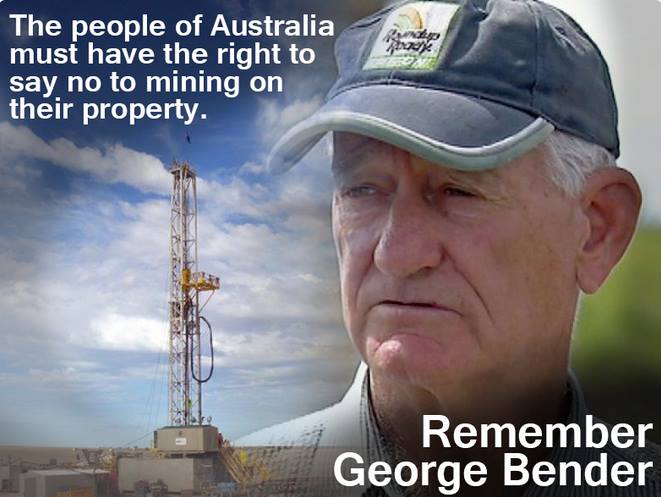

Ghost Net Retrieval A Work Of Art
Joint media release with Australian Fisheries Management Authority10-10-2016 - Maritime Border CommandFollowing a joint operation by the Australian Fisheries Management Authority (AFMA) and Maritime Border Command (MBC) within the Australian Border Force (ABF), a large ghost net has been removed from the Arafura Sea, north-east of Darwin.
The abandoned gillnet was sighted by Australian Defence Vessel (ADV) Cape Byron south of the Australian Exclusive Economic Zone (AEEZ) boundary, North West of Cape Wessel during patrol on 29 September 2016.
ADV Cape Byron, spent several hours retrieving the 800 metre net weighing one tonne. During the retrieval, a number of turtles were released unharmed and a quantity of fish were found dead and discarded.AFMA arranged for the recovery of the net and is in discussion to provide a piece of the net to an Australian gallery for use in a ghost net display.
The rest of the net will be split between indigenous art centres Pormpuraaw Art & Cultural Centre Incorporated and Erub Arts, Darnley Island Art Centre to be turned into ghost net art.
AFMA’s General Manager of Operations, Peter Venslovas, said this latest retrieval was a great outcome; both in removing the threat to the marine life and that the net will now be used to highlight the damage ghost nets inflict on the marine environment.
“Ghost nets wreak havoc on our oceans and AFMA is committed to working with other Australian Government agencies to ensure that this threat continues to be minimised,” Mr Venslovas said.
“Recycling ghost nets for the purposes of art raises public awareness about the impacts abandoned, lost or otherwise discarded fishing gear have on our oceans.”
Commander Maritime Border Command, Rear Admiral Peter Laver, said this operation again illustrates the ABF’s commitment to protecting Australia’s maritime environment.
“Our marine officers play an important role in safeguarding the natural resources and unique biodiversity found across our maritime border,” Rear Admiral Laver said.
“Maritime Border Command is committed to protecting our wildlife by removing these ghost nets. If you do encounter a ghost net I would urge you to report it to Border Watch on 1800 009 623.”
More information on how Australia is working to combat illegal fishing can be found at afma.gov.au
Upper Namoi Valley FMP
Public Exhibition of the draft Floodplain Management Plan for the Upper Namoi Valley Floodplain
What's this about?The proposed Upper Namoi Valley Floodplain Management Plan (FMP) will manage the development of flood works on the Upper Namoi Valley floodplain.
Once the plan commences, all new flood works and amendments to existing flood works will require approval in line with the Upper Namoi Valley FMP prior to their construction. The FMP provides management zones, rules and assessment criteria for determining flood work applications.
Have your sayPublic submissions are now invited on the Draft Upper Namoi Valley FMP.
The draft plan and additional information can be obtained from the DPI Water website - www.water.nsw.gov.au
The exhibition period is open until 28 October 2016 and written submissions must be received by this date.
ExhibitionDate: Sep. 19 - Oct. 28, 2016Time: 9:00am — 11:59pm
More Information
Email Rebecca Ballard: uppernamoi.fmp@dpi.nsw.gov.au 02 6774 9583
Exposure Draft Of The Marriage Amendment (Same-Sex Marriage) Bill
- The definition of marriage would change: The definition of marriage in s 5 of the Marriage Act would be changed to replace “a man and a woman” with “two people”.
- The conditions for a valid marriage would stay the same: It will continue to be the case that a marriage would be void if, for example, the parties are in a ‘prohibited relationship’, consent was not real, or one or both parties are not of marriageable age.
- Foreign same-sex marriages would be recognised in Australia: All valid marriage solemnised under the law of a foreign country, including same-sex marriages, would be recognised in Australia if they are consistent with Australian law. A foreign marriage would not be valid in Australia if the marriage would be unlawful in Australia, for example, if the parties are siblings, in a parent-child relationship, or are polygamous.
- Existing protections for ministers of religion would be retained and strengthened: ministers of religion would be able to refuse to solemnise a marriage on the grounds that the marriage is not the union of a man and a woman, if that refusal conforms to the doctrines, tenets or beliefs of the minister’s religion, or is necessary to avoid injury to the religious susceptibilities of adherents of the religion, or if (irrespective of the teachings of his or her church) the minister has a conscientious objection to same-sex marriage.
- Marriage celebrants (including those who are not ministers of religion) would be able to refuse to marry a same-sex couple: In addition to the existing law whereby marriage celebrants are under no obligation to solemnise marriage, the Marriage Act would be amended to allow marriage celebrants who are not ministers of religion to refuse, on the basis of conscientious or religious beliefs, to solemnise a marriage on the grounds that the marriage is not the union of a man or a woman. Religious bodies and religious organisations would also be able to refuse to provide facilities, goods or services for the purpose of solemnisation of a same sex marriage, or for purposes reasonably incidental thereto, if the refusal conforms to the doctrines, tenets or beliefs of the religion, or is necessary to avoid injury to the religious susceptibilities of adherents to that religion.
More Mental Health Prescriptions Dispensed—But Government Spending Falls Due To Lower Costs
$8.6 Million For Innovative Medical Devices
- Elastagen Pty Ltd ($4 million) for Elastatherapy, a skin regeneration and wound repair product based on its unique tropoelastin-based biomaterial platform used in the surgical treatment of severe scars.
- Nano-X Pty Ltd ($2.5 million) for Nano‐X, a smarter and smaller cancer radiotherapy machine that will enable affordable, accessible best‐practice radiotherapy in resource‐limited areas.
- Respiratory Innovations Pty Ltd ($1.3 million) for Breathe Well, a device that provides breast cancer patients with breath hold instructions to reduce the risk of radiotherapy causing unnecessary and potentially fatal radiation heart damage.
- HEARworks Pty Ltd ($750,000) for the development of the Auditory Cortical Discrimination (ACORD) test to assist clinicians in deciding which hearing‐impaired infants should receive cochlear implants.
Australian College Of Nursing Launches Nurses Are Essential In Health And Aged Care Reform White Paper
- With a workforce of 360,000, the nursing profession is ideally placed to drive health reform in Australia.
- Ensuring the nursing voice is heard in strategic policy debates and reform developments.
- The pursuit of improved access, quality and sustainable health and aged care will only be possible if nurses are supported to allow them to work to their full scope, and expanded scope where necessary.
- Investing in nursing leadership to support systems of mentoring, professional development, resilience and capacity building.
Antarctic Snow Vehicle Goes Pink In Support Of Hope
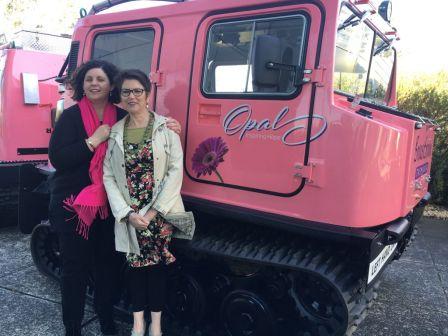
Astroglia Zip The Two Halves Of The Brain Together
Intestinal Diversity Protects Against Asthma
Cortisol-Free Rheumatoid Arthritis Medication Also Works For Rare Eye Disease
Calcium Supplements May Damage The Heart
Greyhound Fiasco: News Corp's Role As PR Co. OfSelf Interest
ACCC Invites Feedback On News Corporation’s Proposed Acquisition Of APN's Australian Regional Media Division
CONDOLENCE MOTION – SHIMON PERES
Have Your Say On A Mixed Use Development At Barangaroo South
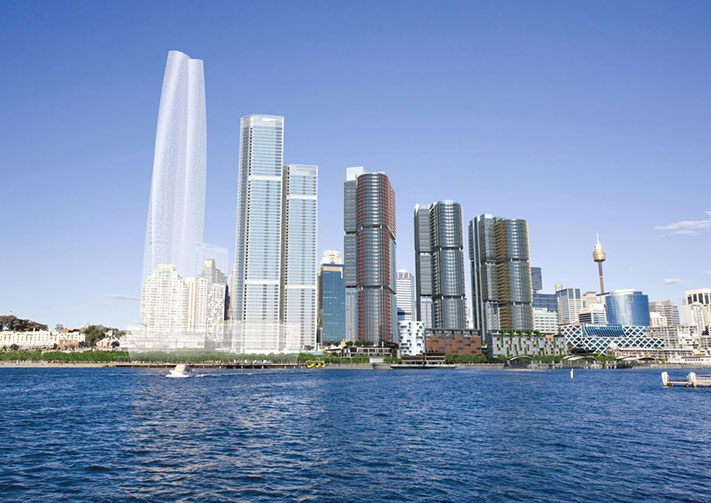
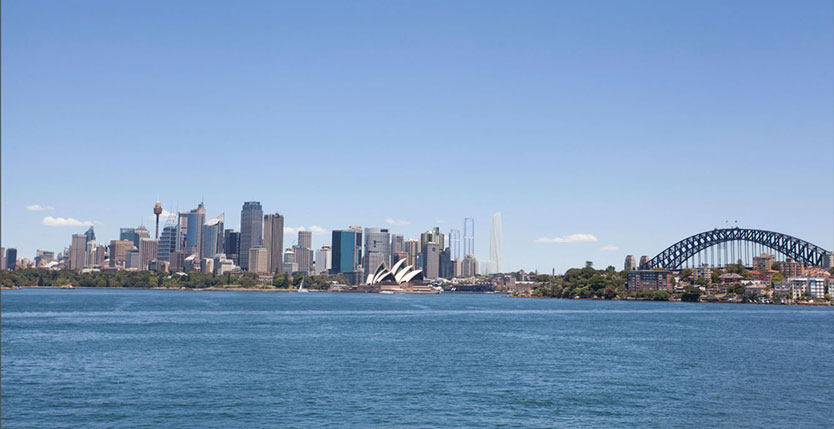
Bush Fire Bulletin Archive Now Online
Iranian Coastal Waters: New Home To A Rarely Seen Venomous Sea Snake
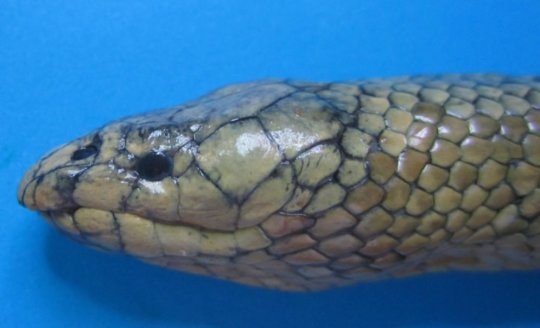
New VET Student Loans Course List Focussed On Employment Outcomes
Mice Sing Like A Jet-Engine
Disclaimer: These articles are not intended to provide medical advice, diagnosis or treatment. Views expressed here do not necessarily reflect those of Pittwater Online News or its staff.
